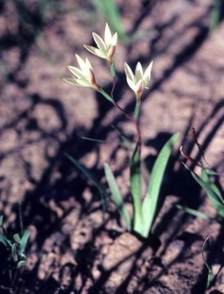Hesperantha sufflava
Hesperantha sufflava Goldblatt
Family: Iridaceae
Common names: evening flower (Eng.); aandblom (Afr.)
Introduction
Once thought to be extinct in the wild, Hesperantha sufflava, a delicate, cormous perennial, was rediscovered on an urban development site in 2004, antithetically the site was bulldozed later that same year.

© Peter Goldblatt
Description
Description
Hesperantha sufflava is a deciduous perennial with a flat-based, bell-shaped corm having lightly toothed edges. It has three sword-shaped leaves, 8-12 mm long.
Flowers are a beautiful pale yellow with the outer tepals a stunning brown on the outside. The spike consists of 3-6 flowers each of which are 10 mm long.
Seeds are globose to angular and are flattened at the chalazal end (base of the seed where it is attached to the plant).
Flowering is in mid to late winter (from July to August) and seed set is approximately six weeks later.

© Peter Goldblatt
Conservation Status
Status
Hesperantha sufflava was first described in 1999 and two herbarium vouchers were placed in the Compton Herbarium in Cape Town and Missouri Botanical Garden respectively.
Although this species was described as common in 1999 it was not then seen for five years and was thought to be extinct. In 2004, members of the Custodians for Rare and Endangered Wildflowers (CREW) found a small population next to a housing development in Malmesbury. Petitions to the local authorities were made to declare the land a reserve or to hold off development until the Millennium Seed Bank Project (MSBP) could harvest seeds and plants for re-location; however, this was ignored and the site was promptly bulldozed. Hesperantha sufflava was then given the official title of EX (extinct), in the Red Data Book for South Africa. In 2005, while searching for other threatened geophytic plant populations, the MSBP team found a population of over a thousand Hesperantha sufflava ! Seed was collected for the Seed Bank and Kirstenbosch National Botanical Garden. However, celebrations were short-lived as the site has been zoned for more urban housing. Fortunately, the local authorities have now set aside a 'sister' site for conservation and it is planned to introduce H. sufflava to this site. This species is currently being reviewed for the new Red Data list for South Africa and has been given the temporary status of Critically Rare (CR). Unfortunately this species has been sighted so rarely that there are only two pictures by Dr Peter Goldblatt and one line drawing by Dr John Manning who generously allowed us to use it for this article.

© John Manning
Distribution and habitat
Distribution description
The habitat of Hesperantha sufflava is restricted to granitic gravel slopes in Renosterveld in the Malmesbury Hills area of the Western Cape Province. It occurs in shallow soils on east-facing slopes.
Derivation of name and historical aspects
History
Hesperantha is derived from the Greek hesperos, evening, and anthos, flower, referring to the flowers opening late in the day. The species name sufflava means yellowish, referring to the colour of the flowers.
Hesperantha is mainly found in the southwestern Cape, western Karoo and Drakensberg Mountains. There are 77 species within the genus and 34 occur in the Cape. It is often confused with Geissorhiza as the two genera are very closely related, sharing a specific corm morphology.
Ecology
Ecology
As Hesperantha sufflava is an evening flowering species, and as little is known of this species, the pollinators are thought to be long-tongued flies and moths. The flowers open in the late afternoon to early evening and are lightly musk-scented. The seed capsule splits longitudinally and the globose brown seeds fall out with the rocking motion of the wind.
Growing Hesperantha sufflava
Grow
Hesperantha plants are easily cultivated and are best grown in pots. As H. sufflava flowers in the later afternoon, it is best grown in a container and brought indoors in the evenings to enjoy the delicate form and fragrance of the flowers. These small bulbs are best grown en masse as individual flowers get lost in the background of other pots on a balcony or veranda. Pots must be placed where they can receive full daylight or else the flowers will not open in the evening. Alternatively this species can be grown in a rock garden and adds an unusual aspect to the typical dry rockery.
Hesperantha sufflava is best propagated by seed, which must be sown directly into the pots in a medium consisting of 1 part milled bark to 2 parts coarse river sand. Sowing is done in spring (September-October) and bulbs must be kept dry during the summer season.
References
- Duncan, G.D. 2000. Growing South African bulbous plants. National Botanical Institute, Cape Town.
- Goldblatt, P. 1982. Corm morphology in Hesperantha and proposed infrageneric taxonomy. Annals of the Missouri Botanical Garden 69: 370-378.
- Goldblatt, P. 1984. A revision of Hesperantha (Iridaceae) in the winter rainfall area of southern Africa. Journal of South African Botany 50: 15-141.
- Jackson, W.P.U. 1990. Origins and meanings of names of South African plant genera. University of Cape Town Printing Department.
Credits
Carly Cowell
Millennium Seed Bank Project
Kirstenbosch National Botanical Garden
April 2007
Plant Attributes:
Plant Type: Bulb
SA Distribution: Western Cape
Soil type: Sandy
Flowering season: Winter
PH: Acid, Neutral
Flower colour: Brown, Cream, Yellow
Aspect: Full Sun
Gardening skill: Average
Special Features:
Horticultural zones







Rate this article
Article well written and informative
Rate this plant
Is this an interesting plant?
Login to add your Comment
Back to topNot registered yet? Click here to register.